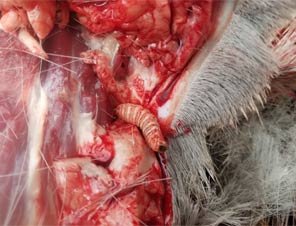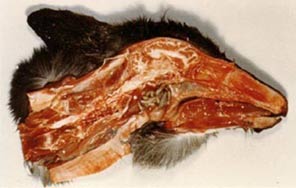Other names: deer nose boats, deer botfly larvae

Nasal bot in the nasal cavity of a deer.
Typically, there are no outward
signs of infection.
Description
Botflies are found globally and parasitize many species of animals such as mice, squirrels, and rabbits. Nasal bots are botfly larvae in the genus Cephenemyia that develop in the nasal passages of deer and many other North American cervids as part of the bot’s natural lifecycle. They typically have little to no impact on deer and do not affect the quality of venison.
Transmission
Transmission of the nasal botfly larvae occurs when an adult female deposits eggs around the mouth or nose of deer. Larvae within the eggs are released when a deer licks their snout and transfers the larvae into the nasal cavity. Within the nasal cavity, the larvae molt and leave the deer when they are mature larvae. They will then develop into their adult fly form on the ground.

Cross-sectional view of nasal bot infection.
Michigan Department of Natural Resources
Wildlife Disease Lab
Clinical Signs
Nasal bots are not visible by looking at a deer. Deer will occasionally cough and sneeze if a nasal bot is causing irritation.
Wildlife Management Implications
In most cases, nasal bots are not harmful to deer or any other species. On rare occasions, animals may die from suffocation if nasal bots do not dislodge themselves. Hunters can discover nasal bots when field-dressing the animal or when the animal is left to cool over a long period of time, and the nasal bots make their way out of the mouth and nose of the animal in search of warmer conditions. Nasal bots do not harm a deer's meat and are not a cause for concern when handling venison.
Human Health Significance
Nasal bots are not a public health concern. They do not pose a risk of disease or parasitism to humans. Venison from deer with nasal bots is safe to eat.
